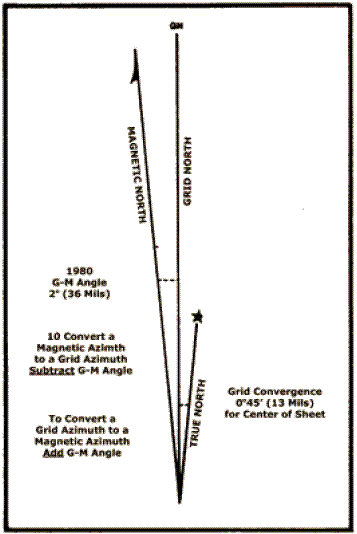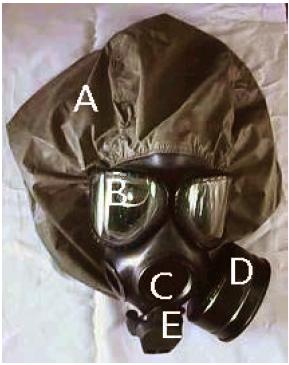| Instructions |
There is only one correct answer for each item. When you have completed the exercise, check your answers with the answer key that follows. |
|
| 1. |
The grid azimuth on the map is 262 degrees. The declination constant for the map is shown in the graphic
below. What azimuth, in degrees, should you follow with your compass?

|
|
| 2. |
The objective is 1800 meters away and your pace count is 130 paces per 100 meters. Using the average pace
count for a normal male Soldier, how many paces is the objective from your position?
|
|
| 3. |
The azimuth to the objective is 160 degrees. Where should you set the black index line on the compass?
|
|
| 4. |
You determine that moving 1130 paces following a magnetic azimuth of 160 degrees will take you to your
objective. While moving to the objective, you encounter a lake shown in the graphic below.
You have reached point D. How many paces do you have to take to reach the objective?
|
|
| 5. |
You are a member of a unit in a combat situation. You are operating in a remote location without direct
mortuary services support. Your unit commander has directed the recovery and evacuation of U.S. remains
from a previous battle. If conditions do not favor evacuation, your commander has authorized emergency
temporary interment on site. Use this situation to answer the following question.
You are recovering a group of several co-located remains, many of which are badly fragmented with a
number of body parts. How should you process the remains?
|
|
| 6. |
A Soldier sustained a neck injury, but is able to move his arms and legs. What action should you take first?
|
|
| 7. |
You are evaluating a battlefield casualty. What is the priority for conducting the following evaluation:
Bleeding -
|
|
| 8. |
You are evaluating a battlefield casualty. What is the priority for conducting the following evaluation:
Breathing -
|
|
| 9. |
You are evaluating a battlefield casualty. What is the priority for conducting the following evaluation:
Fractures -
|
|
| 10. |
You are evaluating a battlefield casualty. What is the priority for conducting the following evaluation:
Responsiveness -
|
|
| 11. |
You are evaluating a battlefield casualty. What is the priority for conducting the following evaluation:
Shock -
|
|
| 12. |
You are treating a casualty with a simple leg fracture. The casualty is showing symptoms of shock. What
should you do?
|
|
| 13. |
How can you be sure you have opened a casualty's airway?
|
|
| 14. |
You have tried to open the airway and the casualty is still not breathing. What should you do next?
|
|
| 15. |
When performing mouth-to-mouth breathing for an unconscious Soldier who has a pulse, how fast should
you breathe?
|
|
| 16. |
You are giving mouth-to-mouth resuscitation. Where should your hands be positioned when giving chest
compressions?
|
|
| 17. |
A toolbox falls on a Soldier's lower arm. The sleeve is not torn and is quickly getting soaked with blood.
What should you do first?
|
|
| 18. |
Your unit is operating in MOPP 4. A Soldier, who is masked and in protective clothing, is hit by shrapnel
when a round lands. The sleeve of the Soldier's protective clothing is slightly torn, and you can see that the
Soldier's arm is bleeding. What should you do?
|
|
| 19. |
A Soldier receives a deep cut on the arm. The Soldier's sleeves were rolled back so you can see the cut has
dirt in it. What should you do first?
|
|
| 20. |
You have tied a pressure dressing to a casualty's injured limb.The pressure dressing has stopped the bleeding.
What should you do next?
|
|
| 21. |
You have acquired a man-sized target with your M16 using a night sight AN/PVS-4 and want to determine
the range. The reticle reveals the following image. What is the range to the target?

|
|
| 22. |
After donning your protective mask, how should you check the mask for proper seal?

|
|
| 23. |
Match the following radio transmission explanations with their correct prowords:
End of my transmission and no
answer required.
|
|
| 24. |
Match the following radio transmission explanations with their correct prowords:
End of my transmission and
response is necessary.
|
|
| 25. |
Match the following radio transmission explanations with their correct prowords:
What is my signal strength?
|
|
| 26. |
Match the following radio transmission explanations with their correct prowords:
Received your last transmission loud and clear.
|
|
| 27. |
Match the following radio transmission explanations with their correct prowords:
Received your last transmission and will comply.
|
|
| 28. |
When performing voice communications on a net, the net control station (NCS) initiates a close-down order.
Who is the last person to speak over the net during the close down sequence?
|
|
| 29. |
You are part of a radio net with multiple net members. You receive a close-down order from the net control
station (NCS). In what sequence should net members respond to the close-down order?
|
|
| 30. |
You are entering a radio net. In what sequence should net members answer the net control station (NCS)
when a net call has been issued?
|
|
| 31. |
What is the maximum effective range of most common rocket propelled grenades (RPG), such as RPG-7?
|
|
| 32. |
What type of signature should you look for to identify the position of an enemy anti-tank guided missile
(ATGM), such as an AT3, 4, or 5?
|
|
| 33. |
You are using the rush technique for movement under fire. How long should the rush last?
|
|
| 34. |
You are moving under direct fire and speed of movement is not a requirement. Which movement technique
should you use?
|
|
| 35. |
You are under enemy fire and need to move to a better firing position. You are now behind a large tree, and
coverage between the tree and the position you want to go to is spotty - trees, rocks, stumps, with some open
space between them. What should you do?
|
|
| 36. |
What type of major threat capability involves collecting, evaluating, analyzing, integrating, and interpreting
information derived from intercepted electromagnetic emissions?
|
|
| 37. |
Which of the following is not a step in the operations security (OPSEC) process?
|
|
| 38. |
You are controlling entry to and exit from a restricted area and are using a multiple badge system. You have
no special orders. What must you brief the visitor on prior to entry into the area?
|
| 39. |
You are preparing to disassemble the M60 machine gun. Where should the bolt be positioned for
disassembly?
|
|
| 40. |
You are disassembling the M249 machine gun. Where should you position the bolt before you remove the
drive spring?
|
|
| 41. |
Who has the authority to impose an Article 15?
|
|
| 42. |
Which is not an Article 15 classification?
|
|
| 43. |
What authority is required for imposing a Field Grade Article 15?
|
|
| 44. |
Indicate whether the following term is a classification of an Article 15 or a court martial:
Field grade -
|
|
| 45. |
Indicate whether the following term is a classification of an Article 15 or a court martial:
General -
|
|
| 46. |
Indicate whether the following term is a classification of an Article 15 or a court martial:
Summary -
|
|
| 47. |
Indicate whether the following term is a classification of an Article 15 or a court martial:
Summarized -
|
|
| 48. |
Indicate whether the following term is a classification of an Article 15 or a court martial:
Company grade -
|
|
| 49. |
What should you do to be sure the grenade explodes before the enemy can pick it up and throw it back?
|
|
| 50. |
You find a hand grenade upside down in its packing container. What should you do?
|
|
| 51. |
You are checking the operation of the sear of an M203 grenade launcher. You cock the launcher and pull the
trigger. What should happen next?
|
|
| 52. |
You are disassembling an M203 grenade launcher. You have removed the quadrant sight and are next going
to remove the barrel assembly. What is the sequence for removing the barrel assembly?
Depress the barrel stop -
|
|
| 53. |
You are disassembling an M203 grenade launcher. You have removed the quadrant sight and are next going
to remove the barrel assembly. What is the sequence for removing the barrel assembly?
Push the barrel latch -
|
|
| 54. |
You are disassembling an M203 grenade launcher. You have removed the quadrant sight and are next going
to remove the barrel assembly. What is the sequence for removing the barrel assembly?
Insert a cleaning rod on left side of handguard in the fourth hole
from the muzzle -
|
|
| 55. |
You are disassembling an M203 grenade launcher. You have removed the quadrant sight and are next going
to remove the barrel assembly. What is the sequence for removing the barrel assembly?
Move barrel foward until is hits barrel stop -
|
|
| 56. |
You are performing a function check of your M203. You have cocked the launcher and pulled the trigger.
What should the firing pin do?
|
|
| 57. |
You are checking the operation of the sear on your M203. You hold the trigger to the rear and cock the
launcher, then you release the trigger and pull. Which of the following should the firing pin do?
|
|
| 58. |
The MK19 will not fire, and in trying to determine the cause, you discover the male link ammo is first. What
should you do?
|
|
| 59. |
When employing the M136 (AT4) launcher against enemy armor targets, what is the most preferred method
of engagement to increase the probability of a target kill?
|
|
| 60. |
When employing the M136 (AT4) launcher against enemy armor targets, what is the preferred point of
engagement?
|
| 61. |
When disassembling the M16/M4 series weapon, how do you remove the bolt cam pin from the bolt carrier?
|
| 62. |
How, if at all, should you remove the trigger from your M9 pistol?
|
| 63. |
You are performing a function check on the M9 pistol. You have inserted an empty magazine. What is your
next step?
|
|
|
| | | |

